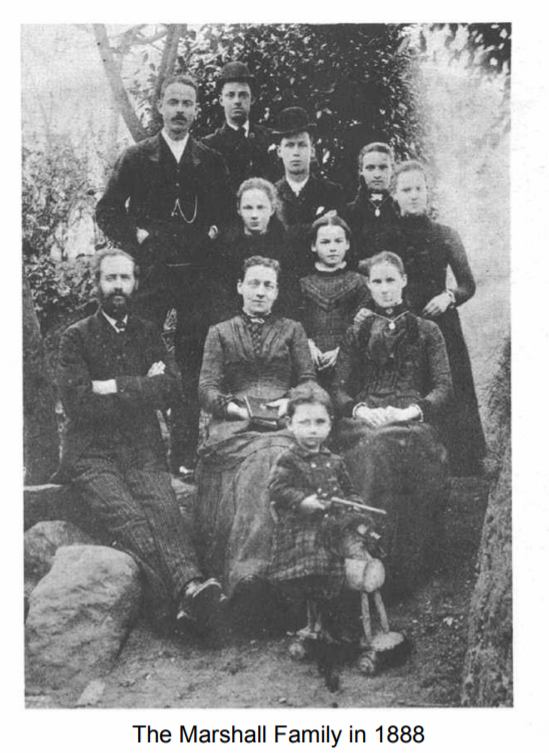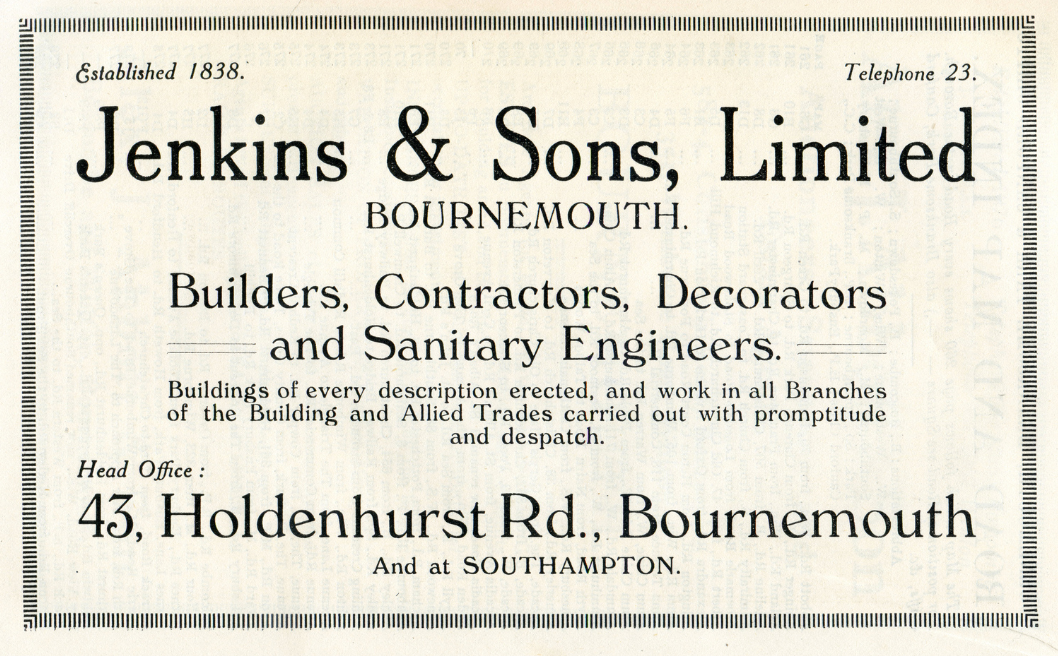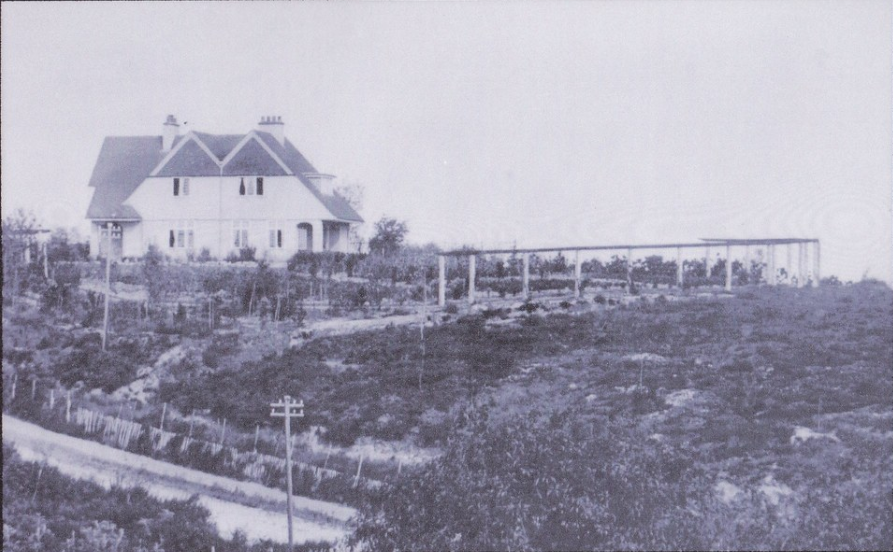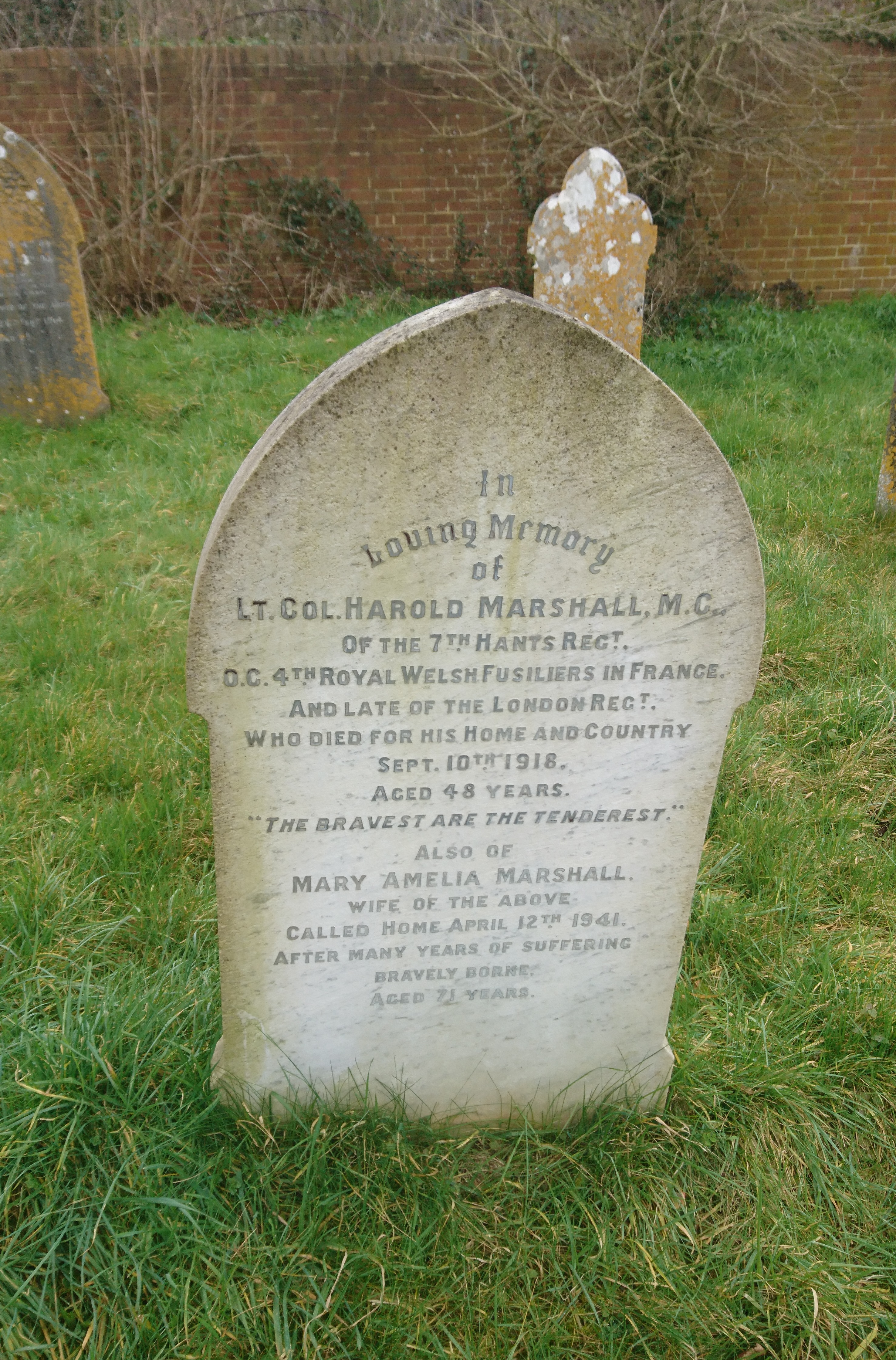 Regiment: 7th Battalion Hampshire Regiment, attached 1st/4th Battalion, Royal Welch Fusiliers
Regiment: 7th Battalion Hampshire Regiment, attached 1st/4th Battalion, Royal Welch Fusiliers
Date & place of birth: 25 March 1870 at Kinson, Poole, Dorset
Date & place of death: 10 September 1918, aged 48 at Kinson, Poole, Dorset
Harold Marshall was a builder by profession. In the early years of the war, he served in India, before becoming Commanding Officer of two battalions on the Western Front. He died at home from the effects of gas poisoning.
Family
 Harold Marshall was born at Redhill, Kinson to the north of Poole on 25 March 1870, the fourth of eleven children born to Charles Marshall (1842–1908) and his wife Love née Lawford (1841–1921).
Harold Marshall was born at Redhill, Kinson to the north of Poole on 25 March 1870, the fourth of eleven children born to Charles Marshall (1842–1908) and his wife Love née Lawford (1841–1921).
Charles Marshall was the son of a farmer but left the farm as a teenager and trained as a bricklayer. He married Love Lawford in 1865 and their first son, Ralph, was born the following year, followed by three more sons, Hugh, Leigh and Harold over the next four years, all born at the family home at Redhill. By this time, Charles had established himself as a builder, and was a staunch Congregationalist, and secretary of the Christchurch and Bournemouth Liberal and Radical Association. After Harold, the couple had six girls, with their last child, Pascoe being born in 1886.
Harold’s first job after leaving school was as a clerk with Edward Guillaume, Solicitor in Yelverton Road, Bournemouth before joining Jenkins and Sons, builders, in Holdenhurst Road.
On 6 October 1892, at the Congregational Chapel at Throop, on the northern outskirts of the present day Bournemouth, Harold married his cousin, Mary Amelia Marshall, known as “Min”, the daughter of Charles Marshall’s brother, Stephen. Their first house was a cottage in Malvern Road, Moordown, before moving to a large four-storey house in Cotlands Road, close to the centre of Bournemouth, where Min set up a boarding-house for young men.
In 1896, Jenkins & Sons opened a branch at Portland Place in Southampton, with 26-year old Harold as the manager. Harold and Min initially lived above the company’s offices, until the business moved to new premises in Above Bar when the couple moved to Highfield. Later, the business was converted into a Limited Liability Company, with Harold as joint managing director. He subsequently became chairman of the Southampton Master Builders Association.
 At the time of the 1911 census, Harold and Min were living at 21A Ordnance Road, Southampton, but shortly afterwards he purchased a plot of land at Redhill Common on what is now Redhill Drive, where he built his new home, “Restmore”, alongside which he set up a chicken farm.
At the time of the 1911 census, Harold and Min were living at 21A Ordnance Road, Southampton, but shortly afterwards he purchased a plot of land at Redhill Common on what is now Redhill Drive, where he built his new home, “Restmore”, alongside which he set up a chicken farm.

Harold and Min had no children. Harold was a keen yachtsman and a member of the Royal Southampton Yacht Club.
Masonic career
Harold was initiated into The Southampton Lodge No 394 on 19 October 1905, passed to the second degree on 21 December and raised to the degree of Master Mason on 18 January 1906.
He joined The Hampshire Lodge No 3538 (meeting in London) on 20 January 1913, but resigned in October 1914, when his battalion set sail for India.
Military service
Hampshire Regiment
When he was 18, Harold followed his two elder brothers, Ralph and Hugh, when he joined the 4th Volunteer Battalion, Hampshire Regiment as a “citizen soldier”, based in Bournemouth. Following his move to Southampton, now a Colour-Sergeant, Harold transferred to the Totton Company of the Hampshire Regiment. On 29 March 1905, Harold was commissioned as a Second Lieutenant in the 4th Volunteer Battalion.
In August 1908, the Army was reorganised with the 4th Volunteer Battalion becoming the 7th Battalion, Hampshire Regiment, with Harold retaining the rank of Lieutenant and his brother Ralph as Quartermaster and Honorary Captain. On 8 March 1911, Harold was promoted to Captain, becoming Commander of his company.
When war was declared on 4 August 1914, Harold immediately joined the battalion on Salisbury Plain where they were having their annual camp. Along with most of the battalion, he volunteered for service overseas, hoping to be sent to Europe. As part of the Wessex Division, however, they were ordered to India to replace regular British and Indian units who were to be deployed on the Western Front.
They sailed from Southampton on 19 October 1914, travelling via Malta and Suez and arrived at Karachi on 11 November, from where they were sent to northern India. In India, the 1/7th Battalion were engaged in “policing” duties based at the cantonment town of Chakrata, situated at an elevation of 7000 feet, about 200 miles north of Delhi.
Harold remained in India until the spring of 1916, when he obtained three months leave and returned to England.
London Regiment
During his time back home at Bournemouth, he discovered that the London Regiment were looking for officers to send to France. He immediately volunteered and was attached to the 1/15th (County of London) Battalion, The London Regiment (Prince of Wales’s Own Civil Service Rifles) with the acting rank of Major, with effect from 17 August 1916. The Civil Service Rifles were members of the 140th (4th London) Brigade in the 47th (1/2nd London) Division.
When he joined up with his new battalion, they were based at Franvillers, midway between Amiens and Albert, where they remained until 12 September when they moved into the front line at Becourt Wood in readiness for an assault on High Wood, (correctly called “Bois des Fourcaux” (Pitchforks Wood)). The wood is situated just north of the villages of Bazentin-le-Petit and Longueval, and stands on a slight ridge with views over the surrounding countryside. The wood had been heavily fortified by the Germans and the attempts by the British forces to capture it had commenced on 14 July. The allies had made repeated attempts to take the wood without success, with both sides suffering horrendous casualties.
On 15 September, the Civil Service Rifles, together with the London Irish and the Poplar & Stepney Rifles launched a further attack. 80% of the Civil Service Rifles became casualties, with two Company Commanders killed, Captains Arthur Roberts and Leslie Davies. The battalion war diary records the death of five officers, with “about 250” Other Ranks killed, missing or wounded, while the Commonwealth War Graves Commission record 139 deaths from the Civil Service Rifles on 15 September 1916. Despite the heavy losses, the attack was successful and, after two months of fighting, the allies had finally secured control of High Wood.
The battalion remained at High Wood until 22 September, when they were withdrawn to Henencourt, 7km west of Albert, where they refitted, with the arrival of a draft of 375 men. They remained behind the lines until early October, when they were again moved forward taking up position at Eaucourt l’Abbaye, ready for an assault on the Butte de Warlencourt (an ancient burial mound off the Albert–Bapaume road) on 7 October. The Civil Service Rifles were part of the first wave of the assault, and were stopped by heavy machine gun fire, suffering heavy casualties. The war diary records that 1 officer was killed and 4 wounded, with 22 Other Ranks killed, 257 missing and approx. 65 injured. (CWGC records the deaths of 109 members of the Civil Service Rifles on 7/8 October 1916.)
The battalion were again withdrawn to Albert, but after a few days were sent by train 100km north to Poperinge, near Ypres in Flanders. They were immediately moved into the front line, in the Bluff sector, until 29 October, suffering light casualties. For the remainder of 1916 and early 1917, the battalion alternated between periods in the front line trenches, with occasional raids on the enemy lines, and periods in camp training.
On 13 February 1917, Harold Marshall became the Commanding Officer of the 1/15th (County of London) Battalion, The London Regiment (Prince of Wales’s Own Civil Service Rifles) with the temporary rank of Lieutenant Colonel.
The battalion continued alternating between periods of rest and in the front line with no major engagements with the enemy, until early June. On 7 June, they assisted the Second Army in an attack on the Messines-Wytschaete Ridge, in which the Civil Service Rifles achieved all their objectives, but suffered the loss of 4 officers and 25 men killed, with 2 officers and 120 men wounded and 1 officer and 9 men missing.
Shortly before the Battle of Messines, Harold wrote home:
I have no regrets. I wouldn’t change for anyone in the wide world. All officers, non-coms, and men are quietly confident; they know what they are up against and are prepared to face it. So I think the regiment will make good.
On 7 July, Harold’s temporary role as C.O. of the Civil Service Rifles ended and he reverted to the rank of (acting) Major with a position at Regimental Headquarters, with Lt. Colonel Francis Parish taking over command of the battalion. Colonel Parish was “invalided out” on 23 September and replaced in turn by Lt. Colonel William Segrave, with Harold as his second-in-command.
By the end of November, the Civil Service Rifles had returned to France and were engaged in a major battle at Bourlon Wood, near Cambrai in which they came under a heavy gas bombardment, resulting in the loss of 12 officers and 278 other ranks. On 2 December, Colonel Segrave was hospitalised suffering from the effects of the gas, and during his absence Harold Marshall once again assumed control of the battalion.
Despite their heavy losses, the battalion were ordered back into the front line on 4 December at the village of Graincourt which they successfully defended against an enemy attack.
In the January 1918 New Year’s Honours, Harold was awarded the Military Cross, for “cumulative valuable service”; at about the same time, he was also “mentioned in despatches”.
Royal Welch Fusiliers
In early February 1918, the 47th Division was reorganised, with the loss of one battalion. During the reorganisation, Harold left the Civil Service Rifles to take up command of the 1/4th (Denbighshire) Battalion, The Royal Welch Fusiliers (Pioneers), also part of the 47th Division. As a pioneer battalion, the main roles of the 4th Battalion were the construction of trenches and defences in the forward area, rather than as fighting troops.
At the time Harold joined them, the 4th Battalion were in billets at Ruyaulcourt, 21km south-west of Cambrai, where they remained until 23 February when they moved into billets at Léchelle, 5km further west, from where they were engaged on strengthening the defences at Metz-en-Coutere. On 21 March, the Germans launched their spring offensive (“Operation Michael”) with a heavy bombardment of the allied front line. The 4th Battalion were ordered forward to occupy Metz, about 8km behind the front line.
Although the battalion put up fierce resistance, they were pushed back by the superior numbers of the enemy and by 25 March the battalion were holding a line between High Wood and Bazentin on the old Somme battleground (26km west of Metz) where Harold had been involved in fierce fighting with the Civil Service Rifles 18 months earlier.
On the morning of 23 March, Harold was leading a company when they became separated from the main body of the battalion. Initially, they attempted to hold the line at Neuville-Bourjonval, but this soon became untenable and they withdrew to positions near to Vallulart Wood, near Ytres, eventually regaining contact with the battalion on 25 March.
Over the period from 21 to 25 March, the battalion suffered heavy casualties, with the war diary recording the deaths of 3 officers and 10 men killed, with 1 officer and 4 men taken prisoner, 4 officers and 114 men wounded and 148 men missing. (CWGC records that 36 members of the 4th Battalion lost their lives in that period.)
By the end of March, the battalion were at Senlis, 7km north-west of Albert but were soon back in the front line, entering the trenches at Martinsart, north of Albert, on 5 April. The following day, there was fierce fighting as the allies battled successfully to prevent the enemy gaining a foothold on the west bank of the River Ancre, during which the battalion came under a bombardment of gas shells. On 5/6 April, the 4th Battalion lost 8 officers and 16 men killed, with 2 officers and 71 men wounded, and 10 men gassed, plus 49 men missing, believed killed. Fighting continued over the next few days until the battalion were withdrawn to Puchevillers, 22 km north-west of Albert, from where they were sent a further 44km back to Froyelles, near Amiens, where they arrived on 14 April.
After two weeks behind the lines, the battalion were again moved forward, to a camp at Warloy-Baillon, north of Albert, where they were engaged on improving the communication trenches, coming under occasional enemy bombardment, and later establishing new brigade headquarters at Bresle, on the Albert to Amiens road.
In early June, the allies believed that the enemy were planning a massed tank attack on Amiens, coming from the high ground to the North of the River Ancre. On 6 June, the 4th Battalion were ordered to dig a large trench of more than normal width and depth intended as a tank trap, about 600 yards north of Buire-sur-l’Ancre. At midnight on 8 June, the work was interrupted by a bombardment of gas and artillery, during which 5 men were killed and 16 wounded. The work continued for several days until 18 June, after which the battalion were withdrawn to Crouy-Saint-Pierre, midway between Amiens and Abbeville.
They remained at Crouy refitting and training until 12 July, when they moved back to Hénencourt, west of Albert.
Towards the end of July, Harold Marshall took a week’s leave, during which he was ordered to rest in hospital, before returning to take command of the battalion on 31 July.
Death and commemoration

In mid-August, Harold complained of being “tired”, and he was sent back to England on sick leave. Although not “ill”, he took to his bed to rest, but developed pleurisy, followed by double pneumonia. He lapsed into a coma, from which he never recovered and died at Restmore in the early hours of 10 September 1918, aged 48. The cause of death recorded on his death certificate was pulmonary congestion (from gas poisoning) and meningitis.
Lt. Colonel Harold Marshall was buried on 20 September 1918 at Throop Congregational Chapel with full military honours accompanied by a band formed from New Zealand Royal Engineers from the barracks at Christchurch.
Harold Marshall is commemorated on the 7th Battalion Hampshire Regiment Roll Of Honour, which is now situated at St Peter’s Church, Bournemouth and on the war memorial at St Andrew’s Church, Kinson.
Other family members and subsequent history
Harold’s widow, Min sold “Restmore” soon after his death and moved to 71 Talbot Road, Winton, which she also named “Restmore”.
Min’s health deteriorated shortly afterwards and she remained at Talbot Road, more-or-less bed-ridden until she died there on 12 April 1941. She was buried alongside Harold in the churchyard at Throop Congregational Church.
Harold’s brother, Hugh Charles was also a Freemason, and was initiated into Horsa Lodge No 2208 at Bournemouth on 16 March 1908.
Sources
Ancestry.co.uk
1871 England Census
1881 England Census
1891 England Census
1911 England Census
National Probate Calendar (Index of Wills and Administrations), 1858-1966
Soldiers Died in the Great War, 1914-1919
United Grand Lodge of England Freemason Membership Records, 1751–1921
Atkinson, C.T. The Royal Hampshire Regiment 1914-1918, pp. 41-47
Bournemouth Guardian – 21 September 1918: The Story of One of Bournemouth’s Heroes
CWGC: Casualty details: Lieutenant Colonel Marshall, Harold
Find a Grave: LTC Harold Marshall
Daily Echo, Bournemouth: 10 November 2014 A roll of honour for Bournemouth’s WW1 dead
Great War Forum:
4th Batt Royal Welsh Fusiliers/7th Batt Royal Welsh Fusiliers
Lt Col Harold Marshall (1870-1918)
7th Battalion Hampshire Regiment Roll of Honour
The History of The Prince of Wales’ Own Civil Service Rifles: Chapter XV. Messines, 7th June, 1917
Hampshire Advertiser – 14 September 1918: Death of Colonel Marshall
Holyhead War Memorial: John Henry Williams, Royal Welsh Fusiliers
Infantry Battalion Commanding Officers of the British Armies in the First World War:
Kinson Parish Memorial (St Andrew`s church)
Knight, Jill: The Civil Service Rifles in the Great War: ‘All Bloody Gentlemen’ (2005, Leo Cooper Limited) pp. 97, 107
The London Gazette:
28 March 1905 Issue: 27779 Page: 2366
25 August 1908 Issue: 28171 Page: 6230
7 March 1911 Issue: 28473 Page: 1962
16 October 1914 Supplement: 28941 Page: 8332
23 January 1917 Issue: 29913 Page: 852
6 February 1917 Issue: 29931 Page: 1276
6 February 1917 Supplement: 29932 Page: 1349
27 February 1917 Issue: 29963 Page: 2027
13 April 1917 Issue: 30017 Page: 3509
13 April 1917 Supplement: 30019 Page: 3564
10 August 1917 Supplement: 30225 Page: 8184
27 April 1917 Supplement: 30039 Page: 4072
28 December 1917 Supplement: 30450 Page: 41
21 May 1918 Supplement: 30699 Page: 6078
Masonic Roll of Honour: Lieutenant Colonel Harold Marshall
Men on the Gates Project: Somme. Metz-en-Coutere. 1/4 Bn Royal Welsh Fusiliers. 21-25 March 1918
The National Archives:
WO 374/46245: Lieutenant Colonel Harold Marshall. The Hampshire Regiment.
WO 95/2732/1: 1/15 Battalion London Regiment (Civil Service Rifles) War diary
WO 95/2721/1: 4 Battalion Royal Welsh Fusiliers (Pioneers) War diary
The Wartime Memories Project:
7th Battalion, Hampshire Regiment
World War One Battlefields: High Wood – The Somme
Photograph credits
Marshall family: Marshall, Pascoe – My Story: Memories of Bournemouth and District in the Late 19th and Early 20th Centuries (p. 27)
Jenkins & Sons advertisement: Mates Bournemouth Business Directory 1927
Restmore: www.flickr.com Restmore (see also: this image)
St Andrew’s Church War memorial: Moonfleet of Kinson
Gravestone: Alec Brown
